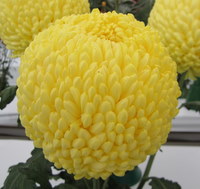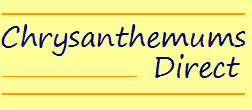
0800 046 74430800 046 7443

Chrysanthemums Direct, Holmes Chapel Road, Over Peover, Knutsford, Cheshire.
Chrysanthemum Classification

All Chrysanthemums are divided into groups, dependent on their colour, type, bloom size and flowering time. This is known as classification and, if you are exhibiting your blooms, it is important to ensure that you show them in the
correct class.
There are six main colour categories: Bronze, Pink, Purple, Red,
Yellow and Salmon, which can also be either Light or Deep. The other groups are White, Cream and Other Colours, bringing the total number of possible
colours to 21. Type refers to the arrangement of petals on the flower and the shape of the bloom, and is often referred to as the 'section', for example,
Reflexed or Incurved. Size is either small, medium or large and, for the purpose of classification, flowering time is divided into either September (Early),
October (Mid) or November (Late). Each of these criteria is represented by
either a number or letter, therefore, each variety can be described by a short code, which indicates its characteristics.
For example: Joyce Frieda (pictured above) is coded 13bY. The number (13) refers to the
flowering time and type or section - '1' being mid-season flowering and '3'
signifying an incurved bloom. The lower case letter (b) is the size of bloom, in this case medium, and the upper case letter (Y) shows the colour, which is
yellow.
The table below gives all the various sections and explains the divisions within them.
correct class.
There are six main colour categories: Bronze, Pink, Purple, Red,
Yellow and Salmon, which can also be either Light or Deep. The other groups are White, Cream and Other Colours, bringing the total number of possible
colours to 21. Type refers to the arrangement of petals on the flower and the shape of the bloom, and is often referred to as the 'section', for example,
Reflexed or Incurved. Size is either small, medium or large and, for the purpose of classification, flowering time is divided into either September (Early),
October (Mid) or November (Late). Each of these criteria is represented by
either a number or letter, therefore, each variety can be described by a short code, which indicates its characteristics.
For example: Joyce Frieda (pictured above) is coded 13bY. The number (13) refers to the
flowering time and type or section - '1' being mid-season flowering and '3'
signifying an incurved bloom. The lower case letter (b) is the size of bloom, in this case medium, and the upper case letter (Y) shows the colour, which is
yellow.
The table below gives all the various sections and explains the divisions within them.
Full Explanation.
| Natural Flowering Time | |||
| Type | November | October | September |
| Large Exhibition | Section 1 | n/a | n/a |
| Medium Exhibition | Section 2 | n/a | n/a |
| Incurved | Section 3 a b c | Section 13 a b c | Section 23 a b c |
| Reflexed | Section 4 a b c | Section 14 a b c | Section 24 a b c |
| Intermediate | Section 5 a b c | Section 15 a b c | Section 25 a b c |
| Anemone | Section 6 a b c | not applicable | Section 26 a b |
| Singles | Section 7 a b c | Section 17 a b c | Section 27 a b |
| Pompons | Section 8 a b | Section 18 a b | Section 28 a b |
| Sprays (See notes) | Section 9 abcdef | Section 19 abcdef | Section 29 abcdef |
| Spiders, Spoons, Quills | Section 10 a b c | not applicable | not applicable |
| Any other types | Section 11 | Section 20 | Section 30 |
| Charms, Cascades | Section 12 a b | Not applicable | not applicable |
| Large October Flowering | not applicable | Section 16 | not applicable |
| Garden Charms | not applicable | not applicable | Section 22 abcdef |
| Explanatory notes: | |||
| Sprays and Garden Charms have the following sub sections a - anemone b - pompons c - reflexed d - singles e - intermediate f - spiders, spoons, quills (single or double) and any other type Spiders, Spoons Quills | Pompons come in two types a - True poms (perfect ball of hard florets) b - semi poms (half sphere with flat base) Charms and Cascades (section 12) All other Sections | ||
Our thanks to Paul Barlow for permission to use his information.

